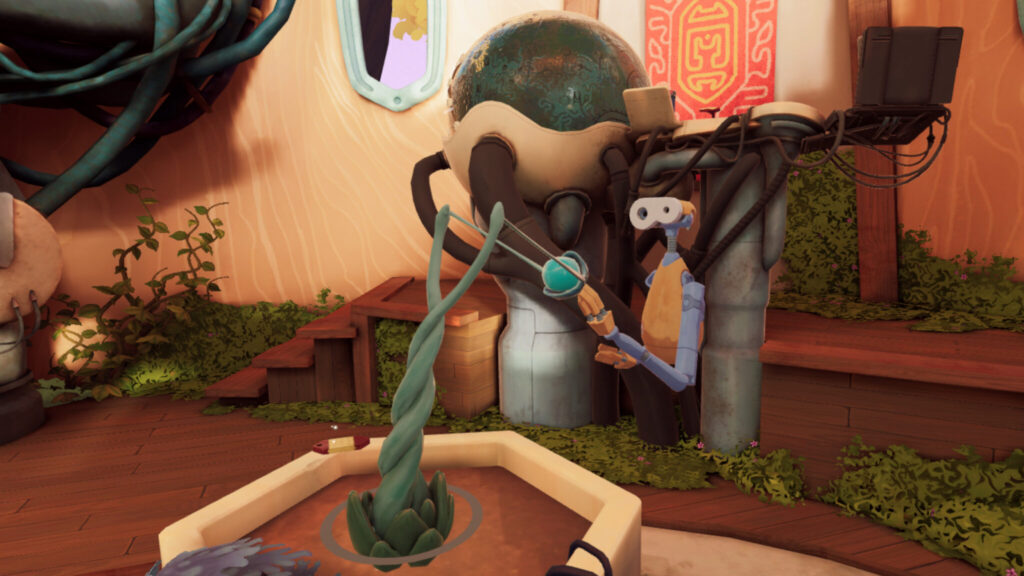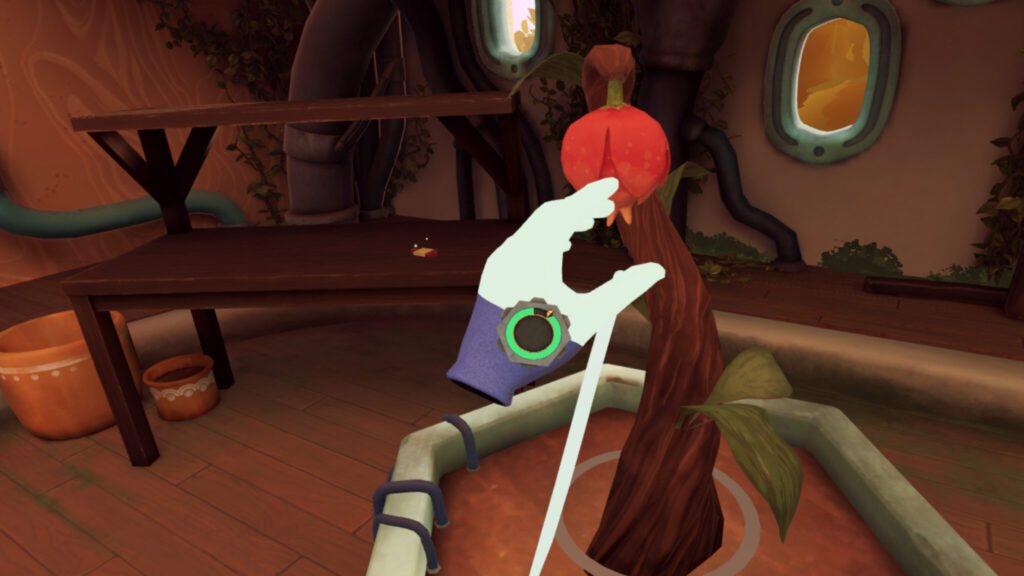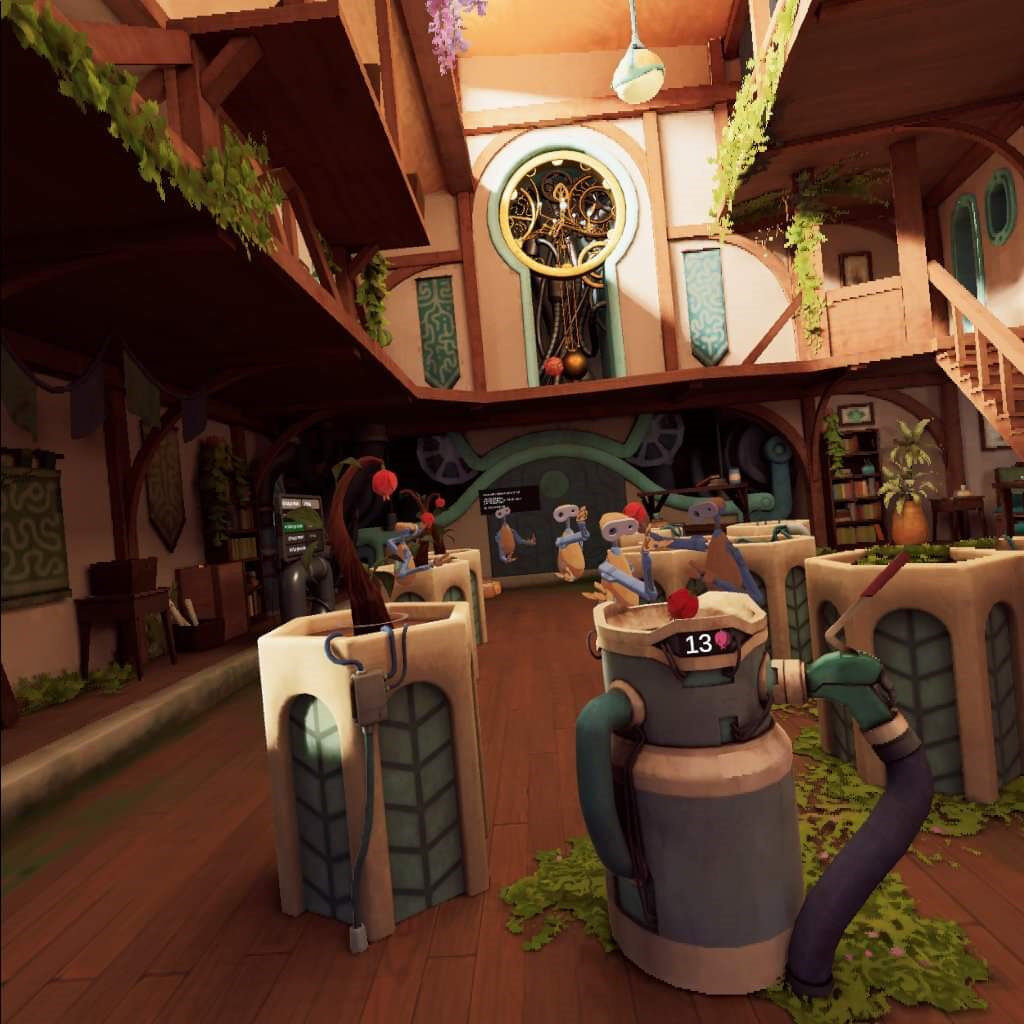Nobody likes repeating themselves but where videogames are concerned repetition can often function as a core mechanic. Having to rinse and repeat (grinding) skirts a fine line between replayability and lazy game mechanics, however, precisely looping yourself over and over becomes an art form in itself in The Last Clockwinder. Almost like creating Rube Goldberg machines with yourself, The Last Clockwinder is a casual puzzler that can almost tie you in knots.

Casual because The Last Clockwinder provides calm, steady gameplay that you don’t need to rush. In fact, trying to complete tasks as fast as possible can be detrimental to the whole thing, because efficiency really is key in Pontoco’s indie gem of a virtual reality (VR) game.
Set within an ancient tree on a sprawling water planet, it serves as a home for seedlings from across the galaxy. Why did humans decide that a tree was a good place for this purpose, you’ll have to play to find out but the water is seeping in and endangering the collection. So you have to fix the pump and other areas of this complex by growing and harvesting fruit to power the various machines housed within.
The developer has been clever with its use of space within the giant tree. Rather than expansive areas to explore or winding corridors to navigate The Last Clockwinder takes place entirely in one room, with a giant globe set to one side allowing you to switch between the various floors. It’s a novel approach making the game world easy to navigate for VR beginners whilst adding that extra level of immersion veteran players demand, being able to grab levers and physically move the globe with your hands.

Physical interaction is very much core to The Last Clockwinder’s gameplay because that fruit isn’t going to harvest itself. Picking and dropping it into a container is just the very start of piecing together ever more complex puzzles that do offer a brain-taxing challenge by the end. All you have to do is record yourself in action and then it’ll loop, creating a whole line of handy robot replicas to do the harvesting for you.
Whilst the Meta Quest 2 didn’t seem to struggle even with a room full of clones going about their looped business, The Last Clockwinder’s real challenge is to optimise that process. That inevitably meant throwing fruit across the room, trying to not only make a perfect throw for the next robot to catch but ensuring the process is so smooth that the harvesting is at peak efficiency. Or not, in which case you just need to be a little more patient trying to build those stores up.
You can, of course, continually record and delete these clones as many times as possible, altering them between 1, 2 and 4-second intervals depending on that overall harmonious machine you’re trying to build. There’s no hand-holding either. Some rooms do offer a hints system that’ll enact a small holographic demonstration to get you started but after that, you’re left to your own devices. The Last Clockwinder’s difficulty never lay too much in figuring out the process as so much in the actual deployment of the solution.

Fruit varieties nicely mix up the puzzle complexity, where the bomb fruits will explode after a couple of seconds in your hands whilst the water fruit can only be flung using catapult-style devices. There’s a certain level of satisfaction once there’s a room full of busy robots toiling away. That’s when you’ll notice the slight imperfections and want to redo just one clone, completely unravelling the whole system.
Complementing the puzzle gameplay is the charming sci-fi narrative where mankind might be exploring the stars yet there’s still room for nature. There’s a very eco-friendly message to the whole narrative partially played out in between levels whilst tape recorders can be found to further reveal the plot. Aside from the odd tape player and the puzzles themselves, The Last Clockwinder doesn’t contain a lot of other interactive features. So if you like little side additions in your VR games then this is a little lacking.
That’s not what bothers me with The Last Clockwinder though. It instead features two of my VR pet hates, disappearing hands and teleportation-only locomotion. Grab anything and the hands vanish which always seemed immersion-breaking to me. I understand it’s easier to build yet suddenly seeing whatever object I’ve just picked up floating in mid-air just doesn’t fit.

Likewise with teleportation. Of course, it should be in there as the mechanic makes the whole experience comfortable for all players, especial when paired with snap turning. The Last Clockwinder works great as a roomscale videogame and having that bit of extra freedom with smooth locomotion would’ve been a real boon when fine-tuning a clone placement. Not game-breaking but a real omission.
The Last Clockwinder is a delightful puzzler all about robots, picking fruit, and the frailties of our natural world. If you love creating Rube Goldberg contraptions but want a game with a bit of a twist on that idea then here’s a good alternative. Overall it’s well crafted, lovely to look at, and for those that desire perfection in their puzzle-solving, The Last Clockwinder should provide a good few hours of entertainment.
- a
- About
- across
- Action
- All
- Allowing
- alternative
- always
- Ancient
- approach
- Art
- because
- being
- between
- Bit
- bomb
- build
- business
- Catch
- certain
- challenge
- collection
- complete
- completely
- complex
- Container
- continually
- Core
- Couple
- Creating
- Demand
- Depending
- deployment
- Developer
- Devices
- DID
- disappearing
- Doesn’t
- efficiency
- ensuring
- Entertainment
- experience
- explore
- FAST
- Features
- fine
- fit
- Fix
- form
- found
- Freedom
- from
- full
- function
- further
- Galaxy
- game
- gameplay
- Games
- globe
- going
- good
- grab
- great
- grinding
- Growing
- harvest
- Harvesting
- having
- Home
- However
- HTTPS
- Humans
- idea
- interaction
- interactive
- IT
- itself
- just one
- Key
- Level
- levels
- Line
- little
- Look
- love
- machine
- Machines
- make
- MAKES
- Making
- Meta
- might
- more
- move
- Natural
- Nature
- Navigate
- offer
- optimise
- Other
- overall
- own
- perfect
- Physically
- planet
- Play
- player
- players
- possible
- power
- precisely
- process
- provide
- pump
- purpose
- puzzle
- quest
- Reality
- record
- review
- robot
- Rooms
- rush
- satisfaction
- seconds
- set
- small
- Snap
- So
- solution
- some
- Space
- start
- started
- Still
- stores
- Switch
- system
- tasks
- The
- thing
- Throwing
- TIE
- times
- together
- twist
- understand
- use
- various
- veteran
- Virtual
- Virtual reality
- vr
- Water
- What
- Whilst
- within
- works
- world
- Your













